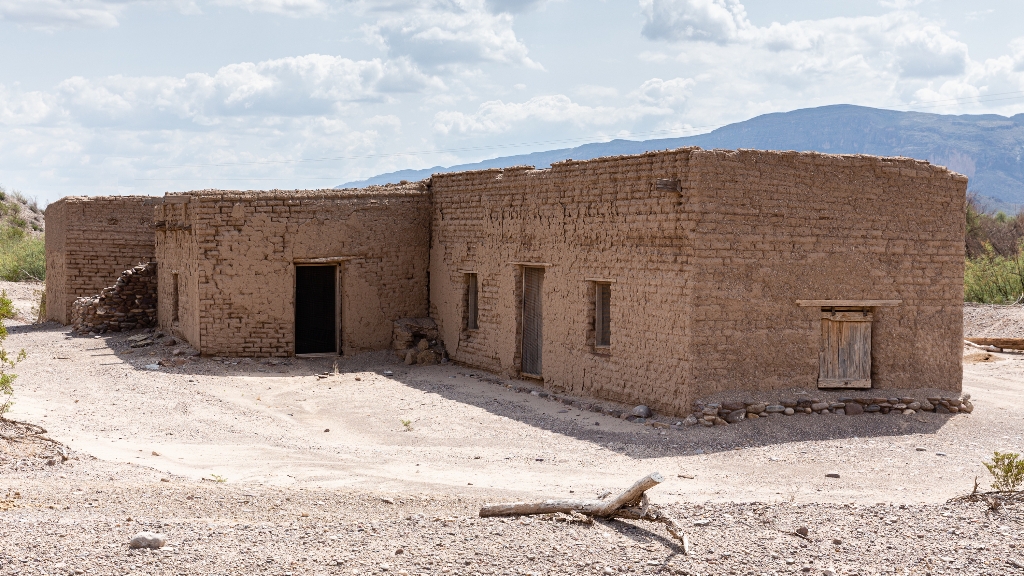
The Alvino House is the oldest intact adobe structure in Big Bend National Park. The building represents the everyday life of the many families who lived and farmed along the Rio Grande. This building was constructed around 1901 by Cipriano Hernandez, one of the Hispanic settlers who farmed near Castolon. He raised vegetables and grain for sale to the mining camps. Corn, beans, squash, tomatoes, and melons were common crops grown by families along the Rio Grande.
As the population grew, Hernandez enlarged his home and used the space to open a small store where he sold supplies to his neighbors. In 1918, Alvino Ybarra moved into the house. In 1922, Alvino married Teofila Luna and raised three sons and three daughters in the house. Even in this remote area, education was a priority, so the Ybarra children attended school for four months in Castolon, then four months in Terlingua, as there were not enough teachers to keep both schools open for an entire school year.
Alvino earned his living by operating the engines that powered the cotton gin and the water pump that brought water from the Rio Grande to irrigate the fields. He worked from 5 a.m. to sundown, earning premium wages for the area of $1.50 per day. This was further supplemented by working as a La Harmonia Company tenant farmer. The Alvino House also served as a civil center for area residents. Alvino’s family set aside a room as a religious shrine, where a priest performed masses, baptisms, and weddings several times a year. The community also celebrated holidays at the Alvino House, coming together as friends and family.
Teofila Ybarra died in 1936, but Alvino continued living here until 1957, when he moved to Alpine. Several of their grandchildren still live in the Big Bend region.The Alvino House affords a close look at a recently repaired and stabilized adobe structure. Adobe masons from Santa Helena, Mexico used their expertise to restore this structure in 1994. The men manufactured adobe bricks on the site, shored up the sagging roof, and repaired the walls. The berm around the foundation of the structure was built in 2008 to protect it from floodwaters.
As the population grew, Hernandez enlarged his home and used the space to open a small store where he sold supplies to his neighbors. In 1918, Alvino Ybarra moved into the house. In 1922, Alvino married Teofila Luna and raised three sons and three daughters in the house. Even in this remote area, education was a priority, so the Ybarra children attended school for four months in Castolon, then four months in Terlingua, as there were not enough teachers to keep both schools open for an entire school year.
Alvino earned his living by operating the engines that powered the cotton gin and the water pump that brought water from the Rio Grande to irrigate the fields. He worked from 5 a.m. to sundown, earning premium wages for the area of $1.50 per day. This was further supplemented by working as a La Harmonia Company tenant farmer. The Alvino House also served as a civil center for area residents. Alvino’s family set aside a room as a religious shrine, where a priest performed masses, baptisms, and weddings several times a year. The community also celebrated holidays at the Alvino House, coming together as friends and family.
Teofila Ybarra died in 1936, but Alvino continued living here until 1957, when he moved to Alpine. Several of their grandchildren still live in the Big Bend region.The Alvino House affords a close look at a recently repaired and stabilized adobe structure. Adobe masons from Santa Helena, Mexico used their expertise to restore this structure in 1994. The men manufactured adobe bricks on the site, shored up the sagging roof, and repaired the walls. The berm around the foundation of the structure was built in 2008 to protect it from floodwaters.
Is there something we missed for this itinerary?
Itineraries across USA

Acadia

Arches National Park

Badlands

Big Bend

Biscayne

Black Canyon Of The Gunnison

Bryce Canyon

Canyonlands

Capitol Reef

Carlsbad Caverns

Channel Islands

Congaree

Crater Lake

Cuyahoga Valley

Death Valley

Dry Tortugas

Everglades

Gateway Arch

Glacier

Grand Canyon

Grand Teton

Great Basin

Great Smoky Mountains

Guadalupe Mountains

Haleakalā

Hawaiʻi Volcanoes

Hot Springs

Indiana Dunes

Isle Royale

Joshua Tree

Kenai Fjords

Kobuk Valley

Lassen Volcanic

Mammoth Cave

Mesa Verde

Mount Rainier

North Cascades

Olympic

Petrified Forest

Pinnacles

Rocky Mountain

Saguaro

Shenandoah

Theodore Roosevelt

Virgin Islands

Voyageurs

White Sands

Wind Cave

Yellowstone

Yosemite

Zion